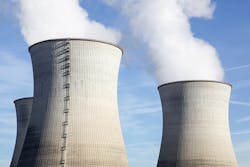Last month marked two significant events: the signing by more than 170 countries (including the United States) of a legally binding accord that phases out the use of hydrofluorocarbons (HFCs) and the 60th anniversary of commercial nuclear power.
The objective of the HFC agreement is to mitigate climate change by reducing greenhouse-gas (GHG) emissions. HFCs, though less harmful to the environment than the chlorofluorocarbons (CFCs) and hydrochlorofluorocarbons (HCFCs) addressed by the Montreal Protocol, often have a high global-warming potential. As I noted in January 2014, when I posted about the phaseout of refrigerants (and my favorite sport, college football), the Kyoto Protocol in 2005 set reduction targets for HFCs, but never was ratified by the United States. In February 2015, I posted an update and said HFCs would be around longer than HCFCs. However, if the timetables agreed upon in the Kigali deal (so-called because the agreement was signed in Kigali, the capital of Rwanda) are met, they won’t be around much longer. Wealthier nations generally will be required to stop production of HFCs much sooner than poorer ones, with the exceptions being countries facing the greatest threats from climate change, such as Africa. By the way, the U.S. Environmental Protection Agency has issued new rules for handling HFCs. Effective Jan. 1, 2017, the leak-rate threshold for previously exempted HFC refrigerants will be lowered from 35 percent to 30 percent for industrial process refrigeration equipment, from 35 percent to 20 percent for commercial refrigeration equipment, and from 15 percent to 10 percent for comfort-cooling equipment.
As for the other significant event, the commercial nuclear-power era began Oct. 17, 1956, when Queen Elizabeth II threw the switch connecting the Calder Hall nuclear power station to the United Kingdom’s national electrical grid. The first nuclear power plant in the world to generate electricity on a large commercial scale, Calder Hall originally produced 60 MW (net) of electric power and—although later derated to 50 MW—operated for nearly 47 years before being decommissioned in 2003. Over Calder Hall’s first three-plus decades, nuclear power grew at an astonishing rate, providing 20 percent of U.S. electric energy by 1991, a level that has remained nearly constant. Many of today’s 448 nuclear power reactors have capacity factors of greater than 90 percent, supplying as much as 77 percent of electric power in France and more than 30 percent in Switzerland, South Korea, and—prior to the Fukushima disaster—Japan. The primary impetus for the growth of nuclear power was, of course, economic. In 1954, Lewis Strauss, chairman of the U.S. Atomic Energy Commission (forerunner of today’s Nuclear Regulatory Commission) said nuclear power would be “too cheap to meter,” and in 1971, then-chairman Glenn Seaborg predicted nuclear power plants would generate nearly all of the world’s electric power by the year 2000. The share of nuclear-generated electricity worldwide peaked at 18 percent in 1996, however, and by last year had fallen to 11 percent. Had Seaborg been right, we might have mitigated some of the climate-change issues we presently face. Unfortunately, nuclear-power accidents (Three Mile Island, Chernobyl, Fukushima), the high cost of reactor construction, and the lack of suitable spent-fuel storage facilities have taken their toll. In August of this year, there were only 61 reactors under construction worldwide, and the only countries with major nuclear-power expansion plans are China, South Korea, and India. Even France, the leader in commercial nuclear power, has plans to scale back.
Nevertheless, nuclear power plants are producing more than twice the electricity as solar photovoltaic cells and wind turbines combined. So, it seems we will be relying on fossil fuels for our power for some time to come. That’s why we must find other ways to reduce GHG emissions, such as eliminating HFCs, a move that admittedly puts a burden on our industry.
About the Author
Larry Clark
A member of HPAC Engineering’s Editorial Advisory Board, Lawrence (Larry) Clark, QCxP, GGP, LEED AP+, is principal of Sustainable Performance Solutions LLC, a South Florida-based engineering firm focused on energy and sustainability consulting. He has more than two dozen published articles on HVAC- and energy-related topics to his credit and frequently lectures on green-building best practices, central-energy-plant optimization, and demand-controlled ventilation.

